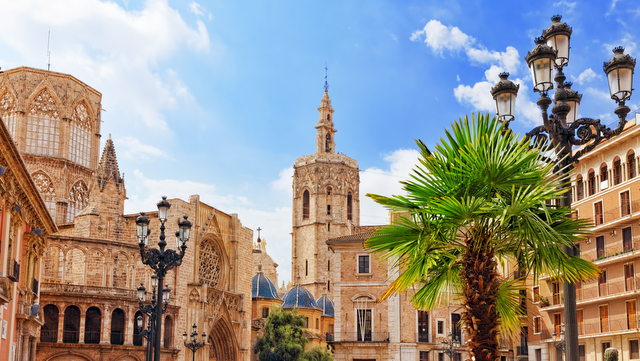
Sun, sea, sand, atmospheric streets and exploding with history, Spain’s third largest city is not one to be missed. Rumoured to be the home of ‘the Holy Grail’ and known as the birthplace of the quintessentially Spanish dish ‘Paella’, Valencia plays a significant role in Spain’s cultural makeup and identity. From the lively fuegos of las Fallas festival to the sleek, futuristic structures of la Ciudad de las Artes y las Ciencias, Valencia truly is a paradoxical blend of tradition and innovation.
With these top 10 free things to do, Valencia’s charm and charisma will certainly captivate your students… without breaking the bank!
1. Las Fallas
Las Fallas de Valencia is one of the biggest events in Spain’s social calendar. Declared an ‘Intangible Heritage of Humanity’, this explosive festival combines tradition, satire and art. In addition to the daily firecracker extravaganzas and the climatic burning of the ninots, you can enjoy a myriad of activities such as music, parades, paella contests and beauty pageants.
2. El Museo Fallero
Missed las Fallas? Take a visit to el Museo Fallero. Here you will find the remains of the ninots indultats that have been salvaged from the flames by popular vote over the years. Free admission on Sundays and public holidays.
3. La Ciutat de les Arts i les Ciències
You don’t have to enter the City of Arts and Science to appreciate this architectural marvel. Designed by the famous Spanish architect Santiago Calatrava, you can enjoy a free photo opportunity in front of one of Europe’s best examples of modern architecture. But if you do want to go inside, admission charges apply.
4. Turia Gardens
These gardens, once the solution to the flooding of the Turia River in 1957, are another fine example of the city’s ingenuity and innovation. Stretching 9km from one end of the city to the other, the gardens offer a unique space for sports, music, food, nature and history. A perfect spot for leisure activities and down time whilst on tour!
5. Ciutat Vella
Strolling through the streets of Valencia’s ‘old town’ is a real journey through time. The heart of the district houses the city’s gothic style cathedral, as well as Torres de Serrano and Quart, the Lonja de la Seda, the Town Hall and the Palacio de la Generalitat. You’ll also find the bustling high street of el Carmen sitting against the backdrop of the 14th century medieval wall that delimits this neighbourhood.
6. Mercado Central
Markets are the crème de la crème for students looking to put their language skills to the test! With more than 1,200 stalls of fresh local produce, Valencia’s Mercado Central provides endless opportunities to converse with locals and try the local cuisine… que rico!
7. Playa la Malvarrosa
Take some down time with a visit to la Playa la Malvarrosa. The beach, located just outside the city, offers ample space and a large promenade lined with palm trees and plenty of bars serving local dishes such as Paella or Fideuà.
8. Museo de Bellas Artes
Located in a baroque building, the Fine Arts Museum is one of the most outstanding painting archives and the second largest art gallery in Spain. The works date between the 15th-19th centuries and there’s also a room dedicated to leading painter and etcher Francisco de Goya.
9. Parque Natural de la Albufera
This natural park located 10km from the city is a dreamy oasis of sunsets, boat rides and wildlife. Albufera is also important for understanding the origins of Valencian cuisine. Why, you ask? It’s the birthplace of Paella, after all.
10. Explore Street Art in El Carmen District
Take a stroll through el Carmen and you’ll be bowled over by an abundance of quirky street art. The colourful graffiti, set against the backdrop of cobbled streets and gothic buildings, creates a striking juxtaposition between urban and tradition.